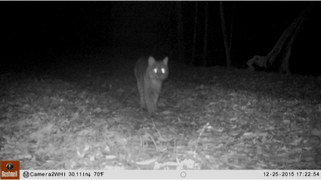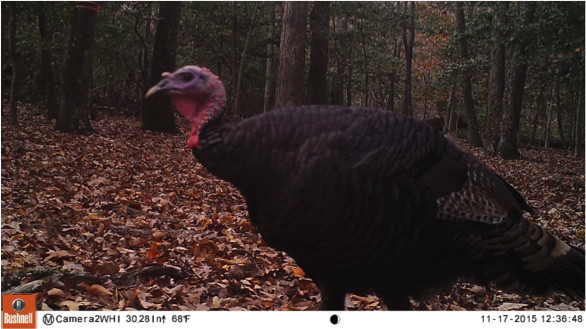 Bobcat caught on film at York River State Park. Image by VMN-Historic Rivers Chapter.
Bobcat caught on film at York River State Park. Image by VMN-Historic Rivers Chapter.
It’s an amazing feat to produce a blockbuster film that captures the awe and curiosity of viewers, a film that raises questions and promotes discussion, a film that begs for sequels. The Historic Rivers Chapter has accomplished such a cinematic wonder with their Wildlife Camera Trap Project.
The Historic Rivers Chapter has an on-going collaboration with our local sponsor, York River State Park, as well as the Department of Conservation and Recreation, one which emphasizes conservation of natural resources. We knew that there was a critical need for photographic evidence of the existence, activity, behavior, and habitat of the wildlife within the park. With a first-time director (Dean Shostak), inexperienced (wildlife) camera crews (at least 24 fellow Master Naturalists), untested equipment (unknown detection needs and capabilities) and filming in a vast, biologically diverse location (York River State Park, over 2,500 acres), we began setting cameras in March, 2015, using game trails as location guides. We recorded GPS coordinates and habitat location. Cameras were re-located approximately every 3 weeks. When retrieve
d, each camera typically produced 100-200 images and videos.
Despite areas difficult to access and the steep learning curve of new technology, our cameras successfully provided photographic evidence of wildlife that has been sighted and anecdotally noted for years at York River State Park—deer, otter, beaver, coyote, fox, and even bobcat; thus not only confirming the existence and territory of these animals but also providing park biologists a means to assess animal health and critical habitat information for future bike path and campsite planning. Park visitors can be guided to observe animals and/or their tracks. Chapter outreach will include working with the park on public exhibitions/presentation of the images and videos. With the data, we are also proud to be developing a new and very unique spreadsheet which will provide images and territory information for any given species with the click of a mouse.
Our first year of filming wrapped up in March, 2016. We have discussed adding more cameras and, given our initial success, we hope to expand our efforts to include other Virginia state parks. Our project is a blockbuster indeed!

